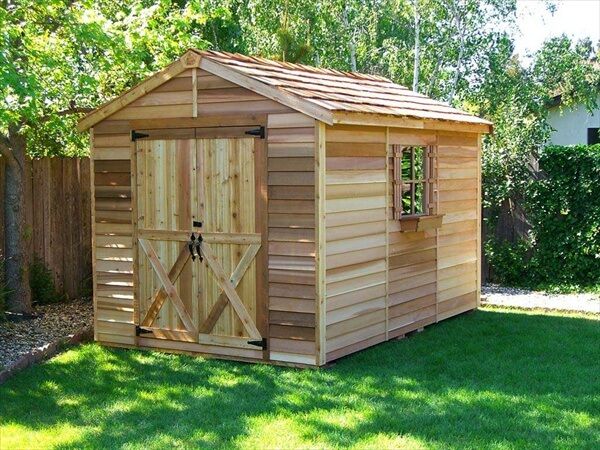Thursday, November 21, 2024
How to Build a Wood Pallet Shed: Simple, Practical, and Budget-Friendly

Constructing a Budget-Friendly Wood Pallet Shed: A Comprehensive Guide
The desire for additional storage space is a common theme among homeowners and property owners alike. Traditional shed construction can prove costly and time-consuming. However, a resourceful and practical alternative exists: constructing a shed from reclaimed wood pallets. This guide provides a detailed, step-by-step approach to building a functional and aesthetically pleasing pallet shed, minimizing costs while maximizing practicality.
I. Planning and Preparation: Laying the Foundation for Success
Before commencing construction, meticulous planning is paramount. This phase ensures the project proceeds smoothly and yields a structurally sound and aesthetically pleasing result. Careful consideration must be given to several key aspects:
A. Shed Design and Dimensions
The dimensions of your pallet shed will be dictated primarily by the available space and your storage needs. Sketching a basic design, including the overall dimensions (length, width, and height), door placement, and window placement (if desired), is a crucial first step. Consider the number and size of pallets required to achieve your desired dimensions. Remember to factor in the thickness of the pallet wood when calculating the final dimensions. Standard pallet sizes are readily available, making them convenient for planning.
B. Site Selection and Ground Preparation
Selecting an appropriate site is critical for both structural integrity and ease of access. Choose a level area with good drainage to prevent water accumulation and potential damage to the shed. Clear the area of any debris, vegetation, or obstructions. For a more permanent structure, consider preparing a concrete slab foundation. For a simpler, temporary structure, a compacted gravel base will suffice. The chosen base will significantly impact the longevity and stability of the shed.
C. Material Acquisition and Assessment
The core material for this project is reclaimed wood pallets. Inspect each pallet thoroughly for signs of rot, pest infestation, or significant damage. Select only pallets in good condition, ensuring they are structurally sound for use in construction. You may need to source pallets from multiple locations, and the quality may vary. It's advisable to acquire more pallets than initially anticipated to account for potential damage or unusable sections. Supplemental materials, including nails, screws, wood sealant, and paint (optional) should also be gathered.
II. Construction Phase: Assembling the Pallet Shed
Once the preparatory phase is complete, the construction process can begin. This involves several distinct stages, each requiring careful attention to detail:
A. Base Construction
Constructing a sturdy base is crucial for the structural integrity of the entire shed. If using a concrete slab, ensure it's level and properly cured before proceeding. For a gravel base, compact the gravel thoroughly to provide a stable foundation. The initial layer of pallets will serve as the shed's floor. Secure them to the base using appropriate fasteners, ensuring a level and stable surface. For improved stability and water resistance, consider adding a layer of plywood or pressure-treated lumber on top of the pallet floor.
B. Wall Construction
The pallet walls are constructed by stacking pallets vertically. Ensure the pallets are aligned and properly secured using nails or screws. Use multiple fasteners per pallet to enhance structural rigidity. Consider reinforcing the corners with additional bracing using sturdy lumber. A plumb bob or level can be used to ensure the walls remain vertical and plumb throughout the construction process. For additional stability, consider using metal corner brackets to strengthen the joints.
C. Roof Construction
The roof design can vary depending on preference and available materials. A simple gable roof is relatively easy to construct. Begin by creating the roof trusses using sturdy lumber and connecting them securely to the top of the walls. The pallets can then be used to create the roof decking, laying them horizontally across the trusses and securing them with nails or screws. Ensure proper overlap to prevent water leakage. Consider adding roofing felt or another waterproof membrane before finishing the roof to further enhance protection against the elements.
D. Door and Window Installation (Optional)
The incorporation of a door and windows significantly enhances the shed’s functionality and aesthetics. If constructing a door from pallets, use sturdy pallets and reinforce the frame. Use appropriate hinges and a latch or lock for security. Windows can be created using pallet sections or purchased pre-made windows. Seal all gaps and openings to prevent drafts and moisture ingress.
III. Finishing Touches: Enhancing Durability and Aesthetics
The final phase involves enhancing the shed's durability, weather resistance, and aesthetic appeal.
A. Sealing and Weatherproofing
Applying a wood sealant or protective coating is vital to safeguard the wood pallets from moisture damage, insect infestation, and weathering. This will significantly extend the lifespan of the shed. Select a high-quality sealant designed for outdoor use. Multiple coats may be necessary for optimal protection. Consider a waterproof membrane beneath the roofing material for added protection against leaks.
B. Painting or Staining (Optional)
Painting or staining the shed not only enhances its aesthetic appeal but can also provide additional protection against the elements. Select a weather-resistant paint or stain suitable for exterior use. Consider applying multiple coats for better durability and color consistency. Choose a color that complements the surrounding environment.
C. Interior Finishing (Optional)
Once the exterior is completed, consider adding interior features to enhance functionality. This might include shelves, hooks for hanging tools, or a workbench. These additions will increase the shed's usability and make it more efficient for storage.
IV. Safety Considerations
Throughout the construction process, prioritize safety. Wear appropriate safety gear, including safety glasses, gloves, and sturdy work boots. Use caution when handling tools and materials. Ensure the work area is well-lit and free of obstructions. Always follow the manufacturer’s instructions for any tools or materials used.
Building a wood pallet shed is a rewarding project that combines practicality, affordability, and environmental consciousness. By following this comprehensive guide and prioritizing meticulous planning and attention to detail, you can successfully construct a durable, functional, and visually appealing storage solution for your property.